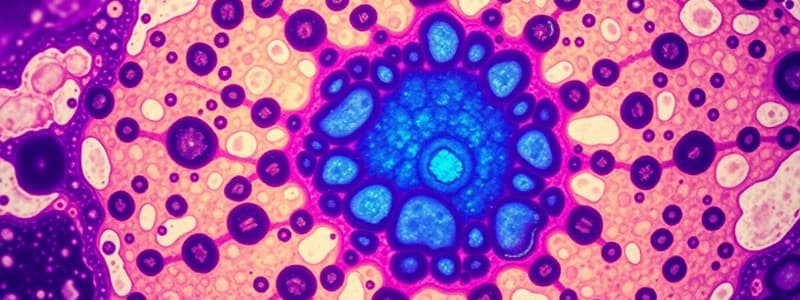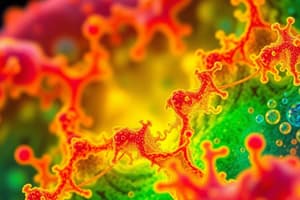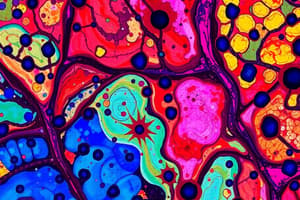Podcast
Questions and Answers
What is histology?
What is histology?
The study of the microscopical structure of normal tissues.
Which type of microscope has the highest maximum magnification power?
Which type of microscope has the highest maximum magnification power?
- Light microscope (L.M)
- Electron microscope (E.M) (correct)
- Both have the same magnification
- None of the above
The optical resolution of a light microscope is about ____.
The optical resolution of a light microscope is about ____.
0.2 μm
Which statement about stains used in light microscopy is true?
Which statement about stains used in light microscopy is true?
The cell membrane is visible with a light microscope.
The cell membrane is visible with a light microscope.
What is the smallest living structure in the body?
What is the smallest living structure in the body?
Match the following types of stains to their descriptions:
Match the following types of stains to their descriptions:
What are cytoplasmic organelles?
What are cytoplasmic organelles?
Cytoplasmic inclusions are _____ structures.
Cytoplasmic inclusions are _____ structures.
Which of the following is a non-membranous cell organelle?
Which of the following is a non-membranous cell organelle?
Flashcards are hidden until you start studying
Study Notes
Histology
- The study of tissues at the microscopic level.
- Aims to understand the microanatomy of cells, tissues, and organs.
- Correlates structure with function.
Microscopy
- Light Microscope (LM)
- Provides optical resolution of 0.2 μm.
- Maximum magnification of x1000.
- Electron Microscope (EM)
- Provides optical resolution of 0.2 nm.
- Maximum magnification of over x100,000.
Cell Staining
- Acidic stains (e.g., eosin): stain basic structures, creating acidophilic appearance.
- Basic stains (e.g., hematoxylin): stain acidic structures, creating basophilic appearance.
- Neutral stains (e.g., Leishman’s stain): combine acidic and basic stains for blood cell staining.
- Vital stains (e.g., trypan blue, India ink): stain living structures within a living organism.
- Supravital stains (e.g., brilliant cresyl blue): stain living cells outside a living organism.
- Metachromatic stains (e.g., toluidine blue): change color after staining due to chemical interaction with cell structures.
- Orcein stain: stains elastic fibers brown.
- Silver stain: stains reticular fibers brown or black, also used for Golgi apparatus demonstration.
- Osmic acid: stains myelin sheath black.
- Histochemical and cytochemical stains: demonstrate substances within cells or tissues based on biochemical reactions.
- Examples:
- Best’s carmine: stains glycogen red.
- Sudan black: stains lipids (fat) black.
- Sudan III: stains lipids orange.
- Examples:
The Cell
- Functional and structural unit of all living tissues.
- Smallest living structure with vital properties, such as growth, secretion, excretion, digestion, and reproduction.
- Cells vary in shape, size, and function but share similar composition.
Cytoplasm
- Contains:
- Cytoplasmic matrix: colloidal solution of proteins, carbohydrates, lipids, minerals, and enzymes.
- Cytoplasmic organelles: essential for cell processes (e.g., respiration, secretion, digestion).
- Cytoplasmic inclusions: non-living, temporary structures – stored substances (e.g., glycogen, fat, pigments).
Cytoplasmic Organelles
- Membranous cell organelles
- Cell membrane
- Mitochondria
- Endoplasmic reticulum (rough and smooth)
- Golgi apparatus
- Lysosomes
- Non-membranous cell organelles
- Ribosomes
- Cytoskeleton
- Microtubules
- Filaments (thin, intermediate, thick)
Cell Membrane
- Definition: Ultra-thin membrane surrounding the cell, forming an envelope.
- LM: Invisible by light microscopy.
Studying That Suits You
Use AI to generate personalized quizzes and flashcards to suit your learning preferences.




